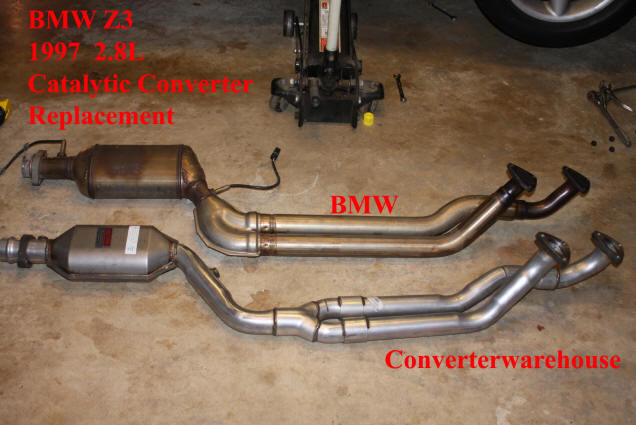Ron Stultz
"Aftermarket Catalytic Converter - A Warning"
Summary: new catalytic converter from dealer is big$'s while after market converters are cheap$'s. Cheap$'s is Environmental Protection Agency (EPA) "approved" and bolt-on. A catalytic converter is just pipe and some special materials inside right? So the cheap$'s aftermarket is the way to go, right?. Well.....be warned.
Background:
1997, BMW Z3, 2.8L, 50,000 miles.
BMW original catalytic converter rattled badly from the internal catalytic material having broken.
Because original more than 8 years old, BMW would not replace although converter was a known problem on this model year Z3.
No check engine light (CEL).
No car performance problems.
BMW retail converter costs $1800.
Aftermarket Converter:
Ok, $1800 from BMW but there are many sources of BMW parts on the Internet and BMW likes to mark up everything they sell, so begin a search. All I can find is $1800 for BMW original converter but plenty of websites sell aftermarket catalytic converters. Many require the existing converter to be cut out of the installed piping and the new "converter" wielded in place. But others are available as bolt-on. Bolt-on: perfect for me or so I think.
So for $300 I get a bolt-on, EPA "approved", 49 state legal (I understand California is different, but I don't live in CA, so hey) catalytic converter. I mean a converter is just some pipe and some special materials inside the converter housing and so how different could the EPA "approved" $300 version be from the BMW "gold-plated" version?
And to be extra safe, I not only order the $300 converter but I also order a new Bosch pre and post catalytic converter oxygen sensors.

Note: image above shows original BMW catalytic converter and new aftermarket converter. Note how much smaller the actual converter section is on the new aftermarket converter. Also note how much different exhaust manifold-to-converter section piping is between genuine BMW and aftermarket.
Check Engine Light (CEL):
Install aftermarket converter and new oxygen sensors and start up car. Can not hear any sort of leak at junction of exhaust manifold and converter pipes and so I good to go, right? Nope. 30 miles later and car throws CEL. What? Perhaps too low an octane fuel, gas cap not sealing properly? Put car on onboard computer scanner (OBDII) and shows code "catalytic converter below threshold." And what does that mean? Website where I bought converter says "below threshold" does not say "converter bad", so I begin check for fuel intake leak or perhaps exhaust leak or vacuum leak but can not find. Blah, blah, blah, jump through hoops for 6 months trying to find problem.

Note: image above shows the pre and post catalytic converter oxygen sensor voltages as measured installed on the aftermarket converter. The red line is the front oxygen sensor and is moving like it should from fuel rich to fuel lean but rear sensor is showing dips in voltage, which indicates converter is not doing its intended function.
One day while at local emissions inspection station, talk to inspector about my problem. "Their facility will not install aftermarket converters because they have had so much trouble getting them to work properly." Oh, not good but how can converter be bad? New, 49 state legal and EPA "approved"??
Continue to try to find problem but every 80 miles after resetting CEL, car throws CEL again.
Finally, I give up and take car to independent BMW repair shop and ask them to do smoke test to find some sort of leak. They tell me right up front that problem probably converter as they just will not install 49 state legal aftermarket converters as they have to guarantee their work and have lost too much money over the years installing aftermarket converters.
They run smoke test and can find no problem. They run there super duper OBDII scanner and the only code is "below threshold." So to fix, they must replace with BMW converter.
Note: image above shows same 2 oxygen sensor but
this time installed in new genuine BMW catalytic converter. Whereas post
converter sensor voltage was not steady when in the aftermarket converter, in
the genuine BMW converter the rear oxygen sensor volts is steady as it should
be. Warning: So I know you are thinking, my car not a BMW and
the aftermarket converter I am going to buy will be 50 state legal and blah,
blah, blah. Or you do not even live in a location that requires emissions
inspection. Ok, but I have warned you. You might be asking for problems. If not
initially, then later. Oh, and EPA "approved" means nothing. An aftermarket
converter has never been tested by the EPA. Their "approval" means that the
converter is similar to the original. And as to "49 state legal", many states
actually require emissions requirements similar if not identical to California's
requirements. Here in Northern Virginia, emissions requirements have been
"California like" since the year 2000.